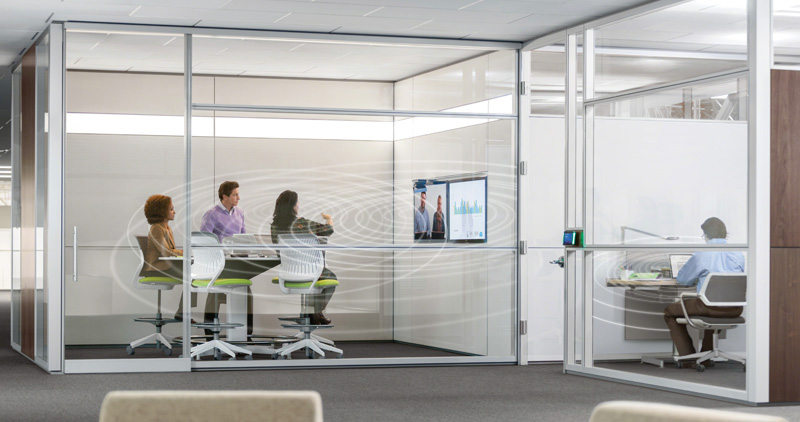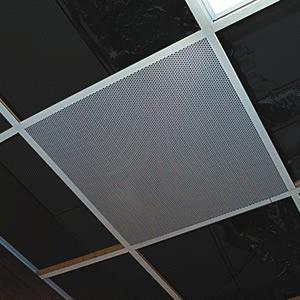You’re on the phone with your banker discussing a preliminary plan to acquire a competitor, a matter of utmost confidentiality and though you’ve closed your door, staff members linger outside of your office discussing last night’s ball game. How do you insure that your conversation is not overheard and that word of your plan is not leaked to the public?
Shooing the staff members away with a broom may be one answer. A speech privacy system is another and more elegant answer.
When you finish the phone call, you step out of your office, walk across the floor and are struck by the level of noise from multiple telephone conversations taking place in cubicles, the clacking of copier machines, the hum of printers, and you wonder how work gets done with all of those distractions. You rightfully become concerned about employee productivity, particularly as you contemplate that acquisition.
There must be a way to mask all of that sound, you think. And you’re right. Sound masking in a business environment has become an effective tool to improve worker productivity, which leads to higher profits.
Over the years, business management has responded to ever-rising operating and occupancy costs by maximizing the use of existing space and a result of this has been that more employees are being squeezed into those existing spaces. Further, there has been a trend to fewer and smaller private offices and more worker cubicles with lower panels to reduce the costs of lighting, heating and air conditioning. One result of these changes has been a loss of speech privacy; another has been the increase in distractive noises, factors that often contribute to worker error.
As has been the case in so many realms of business, technology has come to the rescue. Speech privacy and sound masking systems have been developed and refined over the years to enhance workplace security and productivity. They may deserve your attention.
SPEECH PRIVACY The most effective way to improve speech privacy is to cover the sound with the use of “white noise” emitters that are designed to target frequencies in the range of the human voice. White noise is actually an amalgam of many frequencies, so many that the sound produced is highly unstructured, meaning that it does not communicate a sound that can be translated into information such as a human voice or music. It is a blank slate, if you will, and therefore is unobtrusive. White noise technology has improved considerably as have the machines that generate white noise, to the extent that emitters can be activated by sound or motion.

Office noise can be disruptive
When speech privacy equipment is installed, it must be done in a manner that produces consistent, uniform sound to cover the specified area. The sound should be loud enough to cover conversations but not so loud as to create a distraction. Spacing of the emitters becomes critical to achieving the quietest level of white noise possible to cover sound. The goal is privacy with the least amount of distractive noise. Emitters are installed in a grid pattern, while the sound generating equipment is installed in a central equipment room.

Valcom ceiling tile sound masking speaker
SOUND MASKING It seems axiomatic that when employees are distracted in the workplace, they are less productive. Noises from various sources (conversations, phones ringing, equipment in operation, the cycling on and off of air conditioning units) cause employees to lose concentration, which can result in costly mistakes. Masking is a way to cover distractive noise with sound that is more conducive to a accommodating and productive work environment.
Sound masking emitters or speakers are a cost-effective way to arrest noise in the workplace. An effective electronic masking system must be coordinated with the use of acoustical ceiling tiles, and absorptive office partition panels and furniture. Further, there are specialized systems that emit high intensity masking sounds outside of windows and doors in areas that required additional levels of speech privacy (conference rooms, for example).
Sound masking can be especially beneficial in “public” spaces such as reception areas and waiting rooms, so that visitors will be unable to hear conversations taking place in adjoining work spaces.
Masking devices (speakers or emitters) can be mounted in the plenum area above ceiling tiles, in ceiling tiles or, in some cases, beneath raised flooring, depending on the work area and the source of distractive sound. The idea of a masking system is that it be non-intrusive. It must be ambient background noise, and the emitted sound has to be spread uniformly over the area it is intended to mask. For this to happen, speakers must be placed in an accommodative pattern for there to be uniformity of sound. It is this diffusion of the masking sound that makes it unnoticeable to the ear while producing the desired results.
Speech privacy and sound masking systems thus can provide an environment that supports the economies of an open office plan while providing some of the benefits of private offices. Leading manufacturers of speech privacy and sound masking equipment include VoiceArrest and Valcom.
Visit tsmsouth.com if you would like to learn more about installing speech privacy and voice masking systems.
